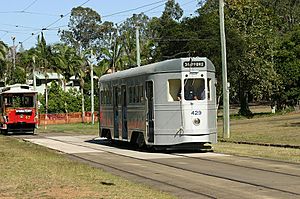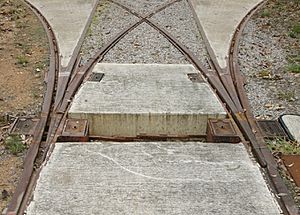Brisbane Tramway Museum facts for kids
The Brisbane Tramway Museum is a special place in Ferny Grove, Australia. It's a museum that keeps old trams and trolleybuses safe. Most of these vehicles used to run in Brisbane from 1897 until 1969. It's like a time capsule for Brisbane's old public transport!
Contents
The Story of the Museum
The idea for the Brisbane Tramway Museum started in 1968. People realized that the Brisbane City Council was planning to stop the city's tram system. To save these important vehicles, the Brisbane Tramway Museum Society was created.
In 1972, a good spot for the museum was found in Ferny Grove. The museum was then built and officially opened its doors in June 1980.
What You Can See at the Museum
The museum has a large collection of old trams and trolleybuses. As of November 2005, there were 25 trams in total. Twenty-four of these trams used to run in Brisbane. The 25th tram came all the way from Sydney.
The museum also has two special trolleybuses. These were built in England by Sunbeam and have bodies made in Brisbane. They are numbers 1 (from 1951) and 34 (from 1960). You can see them on display.
Riding the Trams
Some of the trams at the museum can still move! They operate on a short track that is about 250 meters long. It's a great way to experience what it was like to ride a tram long ago.
The oldest tram you can ride is No. 47, built in 1901. It's called a "California Combination" or "Matchbox" tram. The newest tram in the collection is No. 554, a "Four Motor" tram. It was built after the Paddington tram depot fire and started service in 1964.
Other trams that sometimes run include:
- No. 65, a "Toastrack" tram with 10 benches.
- No. 99, a small "Baby Dreadnought" tram.
- No. 341, a "Dropcentre" tram.
- No. 429, another "Four Motor" tram.
You can often see these trams running on Sunday afternoons. However, they might not operate if the weather is wet.
Other Cool Things to See
The museum also has special support vehicles. These were once used by the Brisbane City Council Tramways Department. One is a tower wagon used to fix overhead wires. Another is a Scammell breakdown truck. This truck was even used to pull artillery during World War II!
Inside the museum, you'll find many old photographs. These pictures show Brisbane's trams and other street transport from the past. There are also old tickets and uniforms worn by tram staff. Drivers and conductors used to wear unusual caps called kepis, which looked a bit like those worn by the French Foreign Legion.
The museum has even more parts of the old Brisbane tram system. The museum's tram garages, called depots, are made from parts of the old Ipswich Road tram depot. The museum's power station, which provides electricity, uses equipment from old Brisbane tramway substations. You can also see an elevated signal cabin that once stood at Brunswick and Wickham Streets in Fortitude Valley.
The short track at the museum was also recovered from old tram lines. It came from places like Ipswich Road depot and Gregory Terrace. The museum built its track in a special way called "mass concrete." This means the track is laid directly into concrete, not on wooden sleepers. This method was used by the Brisbane City Council Tramways Department. It's a very strong way to build tracks, but also very expensive, which is why the museum hasn't been able to make its track longer.
The museum also has a very unique "three-way set of points." These special tracks allow trams to switch to three different directions. They were originally located at the Light Street depot and can now be seen outside the museum's main depot shed.
See also
- List of transport museums
- Brisbane Transport
- Paddington tram depot fire
- Trams in Brisbane
- Bus transport in Queensland



